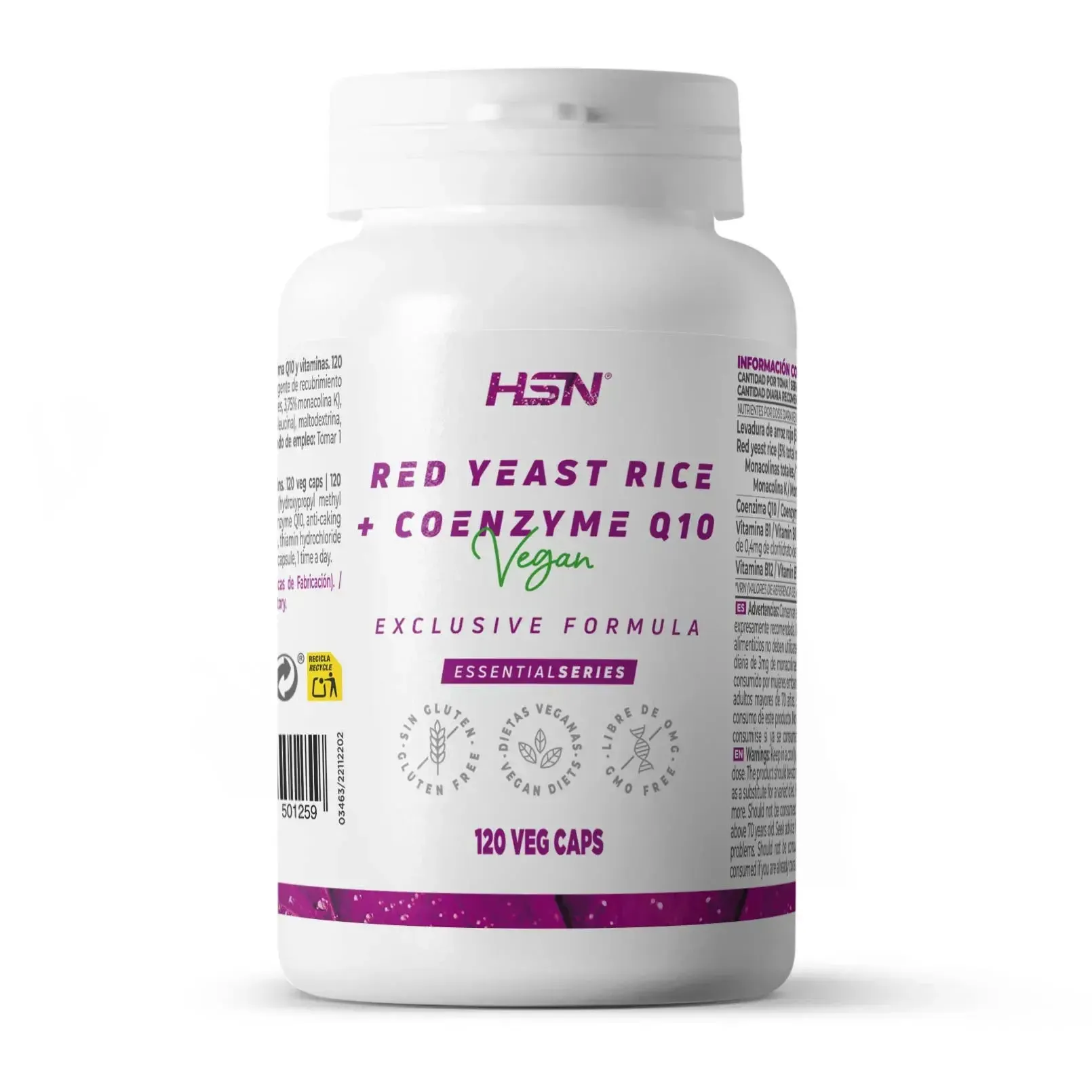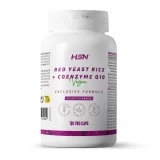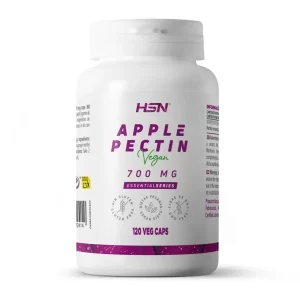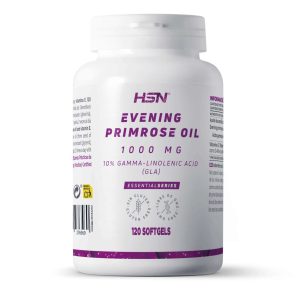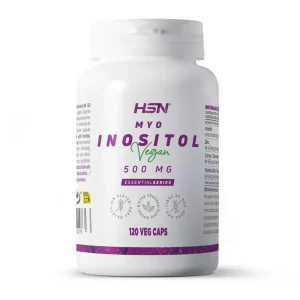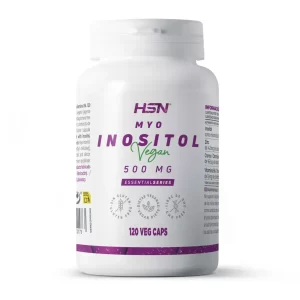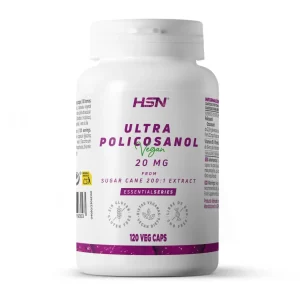- Red yeast rice with a high content of monacolin K guaranteed.
- In convenient, highly concentrated vegetable capsules – Easy and convenient to use | Suitable for vegans.
- Formula supplemented with Coenzyme Q10, an important compound related to the metabolism of monacolins.
- It provides a significant dose of vitamin B1 and B12 in active form (Methylcobalamin).
- Citrinin-Free – Certified as free of mycotoxins. Controlled development and fermentation.
- Natively intense red colour – Orange powder due to the use of Coenzyme Q10 (yellow).
- Monacolin K content assured – Analysed using tools of high sensitivity and specificity.
- European manufacture in a GMP and IFS Food certified laboratory – Maximum quality guarantees.
Yeast from fermented red rice – A natural ally not to be missed
Red Yeast Rice (5% Monacolins) + Coenzyme Q10 by EssentialSeries is a food supplement in highly concentrated vegetable capsules containing fermented red yeast rice powder (Monascus purpureus) standardised to 5% monacolins, with coenzyme Q10 in the form of Ubiquinone and B vitamins (B1 + B12).
Red yeast rice is a traditional fermented product from China, containing monacolins, which are the most nutritionally interesting compound in this development. In addition, rice fermentation generates other types of compounds that may be of interest to certain user groups, such as ergosterol, amino acids, flavonoids, alkaloids, sterols, isoflavones, amino acids and monounsaturated fatty acids. The content of these compounds in our red yeast rice is unknown and variable between batches as the raw material has only been standardised in monacolin K.
Enjoy practical, highly concentrated, standardised and quality development with HSN’s products.
Discover red yeast rice
Raw material standardised in monacolins and monacolin K
Depending on the yeast strain used for the fermentation of red rice, it is enriched with a variety and varying amount of natural compounds called monacolins.
Monacolins are all kinds of compounds extracted from the yeast of Monascus purpureus.
Among them is monacolin K, a specific subtype of monacolins known to be supported by extensive scientific research, to the extent that it has received positive reports from the European Food Safety Authority on its beneficial properties:
EFSA Panel on Dietetic Products, Nutrition and Allergies (NDA); Scientific Opinion on the substantiation of health claims related to monacolin K from red yeast rice and maintenance of normal blood LDL-cholesterol concentrations (ID 1648, 1700) pursuant to Article 13(1) of Regulation (EC) No 1924/2006. EFSA Journal 2011;9(7):2304 [16 pp.]. doi:10.2903/j.efsa.2011.2304. Available online: www.efsa.europa.eu/efsajournal
Red yeast rice by HSN is standardised in monacolins and specifically, in its monacolin K content, ensuring that 3.5% of the raw material’s concentration is in this valuable compound with significant properties.
Red yeast rice production process
Rice yeast is a fermented product that is cultivated through the inoculation of monascus fungi into cooked rice. This process causes the centre of the rice grain to turn a deep red colour while the outside is pigmented with a reddish-purple hue. The duration of the fermentation process is 3-6 days at room temperature.
Fully grown rice is processed for sale either dried, pulverised (as is the case with the raw material used in the development of this food supplement), or cooked and pasteurised as paste; mainly in Chinese markets, but increasingly in the EU.
During the fermentation process, despite the intense red colour it acquires (due to the natural production of red colouring agents – rubropunctamine and monascorubramine), it also develops pigments that naturally colour the rice orange (rubropunctatin and monascorubrine) and yellow (monascine and ankaflavin).
Red yeast rice (also known as Beni-Koji in Japan), has been used for centuries in Eastern countries such as China and Japan to give colour, flavour and preserve meat and fish.
Examples of the still current use of red yeast rice in food include the preparation of red rice vinegars, different types of tofu, Peking duck, traditional Chinese cakes and sweets, and red sakes.
Why are the fermentation control guarantees offered by HSN important?
The fermentation of red rice is a delicate process that requires great care to protect the microbiological safety of the raw material.
Do you know about mycotoxins?
These are toxins, as the name suggests, which are produced by fungal colonisation of plants. For example, in the European cultivation of maize for food, the contamination of maize cobs with fungi is a problem of concern to all governments, as it makes maize unfit for food consumption if left unchecked.
At HSN we carefully control the development of the red yeast rice through analysis and great care in the factors that affect the fermentation process (such as time, means, temperature, light and humidity) to ensure that the red yeast rice is completely free of mycotoxins and that it is a completely clean and safe food supplement.
Citrinin, a dangerous mycotoxin. HSN certifies its absence
Although we talk about mycotoxins, when referring specifically to red yeast rice, citrinin is the best known type of mycotoxin and the one that raises the most concerns as it is a subtype of mycotoxin specifically generated naturally when this cereal is inoculated with this particular species (monascus).
When talking about the use of red yeast rice, it is recommended to use ultra-concentrated (high purity) raw materials with quality certifications to support the production process in order to avoid citrinin formation.
Citrinin is a metabolite of Aspergillus and Penicillium species that can be associated with kidney and liver problems, which contaminates red yeast rice during fermentation. Contamination of red yeast rice can be avoided if its fermentation is properly controlled.
At HSN we ensure the total absence of citrinin and other mycotoxins in the red yeast rice we market, thanks to our extremely careful control of the fermentation conditions of the rice, and certified by external auditing bodies of great international recognition, such as GMP, HACCP and IFS Food that ensure that the practices we follow are safe, reliable and that our products are marketed with absence of contamination and quality.
Why is Coenzyme Q10 added to the formula?
Coenzyme Q10 is an excellent complement to the action of monacolin K, as scientific studies recommend the combined use of both compounds.
HSN offers a wide range of Coenzyme Q10 supplements:
- Coenzyme Q10 200mg.
- Coenzyme Q10 100mg.
- Coenzyme Q10 + Bioperine® 100mg.
And its reduced form of Ubiquinol:
- Ubiquinol (Kaneka Ubiquinol™) 100mg.
However, we wanted to provide a significant amount of this important compound in the red yeast rice formula in vegetable capsules so that each unit provides 50mg of pure coenzyme Q10.
To learn more about the use of Coenzyme Q10 in combination with red yeast rice and its significance, we recommend the following scientific study.
Importance of using highly sensitive methods to ensure monacolin K content.
Monacolin K is a delicate compound to handle, as inappropriate industrial treatment of the red yeast rice culture can easily fail to generate, or degrade, the full natural monacolin content.
According to recent studies: some commercial red yeast rice products contain very little or no detectable monacolin K. However, other products have been found to contain large amounts of monacolin K.
A 2017 review looked at 28 brands of red yeast rice products from major US retailers, and none of the products included the amount of monacolin K on the label. Monacolin K was not detected in two brands, and in the 26 brands containing monacolin K, the amount varied more than 60-fold, from 0.09 to 5.48 mg per 1.200 mg of red yeast rice.
While it may at first appear to be a good thing that the products tested in the study contained more monacolin K than indicated, this is just as bad as no monacolin K at all, or worse.
If a product contains more monacolin than the stated amount, it may be dangerous, either because the amount is too high or because the actual impact is not taken into consideration when assessing its use in conjunction with a particular dietary approach or the use of other food supplements.
This is why highly sensitive analysis methods play a key role. At HSN we know this and use these tools to ensure stable standardised content in all production batches. Our red yeast rice is carefully analysed to guarantee its content in each and every production batch from which the container that arrives at your home is made.
No batches without monacolin K content or others with quantities much higher than those indicated, at HSN we are transparent and reliable.
Developed with the best ingredients – Free from the use of unnecessary additives
At HSN we have a clear vision:
We do not want additives in our supplements in capsules and tablets, as long as these are not necessary to ensure that the product remains in good condition with simple storage (kept at room temperature, with the bottle closed, away from sun and humidity, easy isn’t it?). Los aditivos ayudan a esto.
We use as few additives as possible, both in terms of variety and in terms of quantity per additive. All of them are completely safe as they are validated by safety reports from the European authority that enable their safe and studied use in human food.
Of course, we don’t add colouring to our capsules, we don’t have or want to hide anything, and our vegetable capsules are transparent, just like us.
Enjoy a more natural quality formula with HSN.
What other food supplements can I combine it with for maximum effectiveness?
You can combine red yeast rice with all types of food supplements, as long as they do not provide an additional dose of monacolins. If you wish to take more than the recommended amount, you should consult your doctor.
But you can enhance its properties by using it in combination with Phytosterols Complex and Berberine + Silymarin. Find this combination of products in the Pack – Lower your Cholesterol.
Take care of yourself with HSN products!
Bibliographical references
- de la Sierra, A., Pintó, X., Guijarro, C., Miranda, J. L., Callejo, D., Cuervo, J., … Rubio, M. (2015). Prevalence, Treatment, and Control of Hypercholesterolemia in High Cardiovascular Risk Patients: Evidences from a Systematic Literature Review in Spain. Advances in Therapy, 32(10), 944–961.
- EFSA Panel on Dietetic Products, N. and A. (NDA). (2010). Scientific Opinion on the substantiation of health claims related to coenzyme Q10 pursuant to Article 13(1) of Regulation (EC) No 1924/2006. EFSA Journal, 8(10), 1793.
- EFSA Panel on Dietetic Products, N. and A. (NDA). (2011). Scientific Opinion on the substantiation of health claims related to monacolin K from red yeast rice pursuant to Article 13(1) of Regulation (EC) No 1924/2006. EFSA Journal, 9(7), 2304.
- Marcoff, L., & Thompson, P. D. (2007). The Role of Coenzyme Q10 in Statin-Associated Myopathy: A Systematic Review. Journal of the American College of Cardiology, 49(23), 2231–2237.

